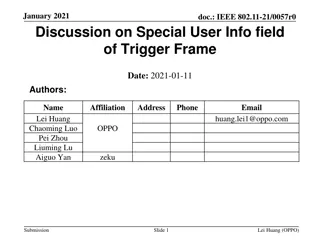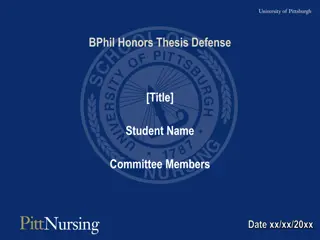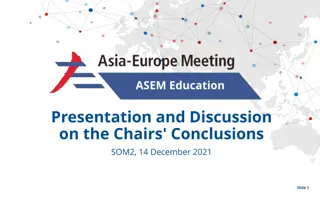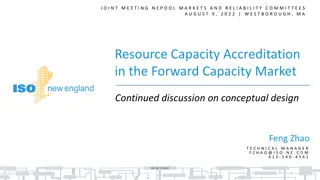Discussion on Distributed RUs (DRUs) in IEEE 802.11-24/0332r0
The document discusses Distributed RUs (DRUs) as a solution to work around 6 GHz regulations limiting transmit PSD per MHz. DRU energizes a few subcarriers per MHz to improve link budget by 11 dB at the cost of data rate scaling. It also examines the problem of throughput degradation in DRU with insufficient users and proposes the Coordinated OFDMA for DRU (C-OFDMA-DRU) as a solution. The uncertain regulatory situation around DRUs is highlighted, emphasizing industry investments in AFC, standard power APs, and dual clients for risk mitigation.
Download Presentation

Please find below an Image/Link to download the presentation.
The content on the website is provided AS IS for your information and personal use only. It may not be sold, licensed, or shared on other websites without obtaining consent from the author.If you encounter any issues during the download, it is possible that the publisher has removed the file from their server.
You are allowed to download the files provided on this website for personal or commercial use, subject to the condition that they are used lawfully. All files are the property of their respective owners.
The content on the website is provided AS IS for your information and personal use only. It may not be sold, licensed, or shared on other websites without obtaining consent from the author.
E N D
Presentation Transcript
Feb 2024 doc.: IEEE 802.11-24/0332r0 Discussion on Distributed RUs (DRUs) Date: 2024-01-10 Authors: Name Brian Hart Affiliations Cisco Systems Address Phone Email brianh@cisco.com Submission Slide 1 Brian Hart, Cisco Systems
Feb 2024 doc.: IEEE 802.11-24/0332r0 Situation The core idea of DRU is a workaround to 6 GHz regulations that limit the transmit PSD per MHz to a relatively low value DRU energize one or so subcarriers per 1 MHz instead of energizing 12.8 subcarriers on average Gains as much as 10*log10(12.8) = 11 dB link budget Data rate is commensurately downscaled. Submission Slide 2 Brian Hart, Cisco Systems
Feb 2024 doc.: IEEE 802.11-24/0332r0 Problem DRU degrades system throughput with insufficient users. Compare achieving a 6 dB better link budget by: Reducing the RU BW (and data rate) by a factor of 4 (75%). Other BSSs/UL OFDMA users can use the other 75% of the bandwidth for their data, for no net loss of system throughput. Reducing the subcarrier density (and data rate) by a factor of 4 (75%). As currently proposed, no other BSSs can use the other 75% of the subcarriers for their data, for a 75% loss of system throughput. At worst, throughput is degraded by 100% - 100% 91.67%. 1/floor(12.8) = Submission Slide 3 Brian Hart, Cisco Systems
Feb 2024 doc.: IEEE 802.11-24/0332r0 Solution Define Coordinated OFDMA for DRU (C-OFDMA-DRU) For both DL and triggered UL Recommendation: conditional mandatory. If an AP transmits a PPDU with DRU then the AP shall support C-OFDMA-DRU as a leader AP Define: AP capability signaling between neighboring co-channel APs: C-OFDMA-DRU as a follower AP (and as a leader AP) AP frame exchanges for the C-OFDMA-DRU feature AP behavior: an AP that uses or triggers DRU in a PPDU and is aware of neighboring co- channel AP(s) that support C-OFDMA-DRU as follower AP(s) shall offer C-OFDMA-DRU to the neighboring AP(s). Submission Slide 4 Brian Hart, Cisco Systems
Feb 2024 doc.: IEEE 802.11-24/0332r0 *Sidebar DRU faces an unclear regulatory situation TBD if regulators will allow / disallow DRU; outcome could vary by regulatory body If regulators allow DRU, TBD if incumbents use their legal avenues to challenge the decision and, if so, whether incumbents succeed / fail; outcome could vary by regulatory body Fortunately, the industry has made a considerable investment in AFC, standard power APs, dual clients and (coming) composite APs In regulatory domains and spectrum where Standard Power operation is allowed and Standard Power APs are available, there is no range issue nor need for DRU // Dual clients operate under the control of both Low Power Indoor APs & Standard Power APs Takeaway: client vendors are urged to obtain dual certification for 6 GHz Following the intent of the spectrum negotiations and the regulatory rules, and As risk mitigation in case the outcome of DRU regulatory discussions is unhelpful Submission Slide 5 Brian Hart, Cisco Systems
Feb 2024 doc.: IEEE 802.11-24/0332r0 Summary To mitigate the system inefficiency of DRU, we propose that DRU should support C-OFDMA-DRU for both DL and triggered UL The use of DRU should be conditional on enabling C-OFDMA-DRU to neighboring APs that can support C-OFDMA-DRU In the meantime, client vendors are urged to obtain dual certification for 6 GHz since this solution is available today, invariably solves the range problem where-ever SP/Composite APs are available and does not come with regulatory risk. Submission Slide 6 Brian Hart, Cisco Systems
Feb 2024 doc.: IEEE 802.11-24/0332r0 Strawpoll 1 Do you support the following: if 11bn defines a mechanism for DRU, then 11bn shall also define a mechanism for C-OFDMA with DRU? Y / N/ A Submission Slide 7 Brian Hart, Cisco Systems
Feb 2024 doc.: IEEE 802.11-24/0332r0 Strawpoll 2 Do you agree to add the following text to the 11bn SFD: If 11bn defines a mechanism for C-OFDMA-DRU (TBD), then an AP using DRU shall offer C-OFDMA-DRU as a leader AP to neighboring APs that support C-OFDMA-DRU as follower APs. Y / N/ A Submission Slide 8 Brian Hart, Cisco Systems
Feb 2024 doc.: IEEE 802.11-24/0332r0 References 23/0037r0, UHR Feature to Overcome PSD Limitations Distributed-Tone Resource Units, Jianhan Liu / Mediatek 23/0281r0, Considerations on RU / MRU Designs for UHR, Eunsung Park, LG Electronics 23/1115r0, CFO Impact and Pilot Design for dRU, Eunsung Park / LG Electronics 23/1117r0, CFO dRU Signaling for UHR, Eunsung Park / LG Electronics 23/1447r0 CFO Impact and Pilot Design for dRU Follow up, Eunsung Park, LGE 23/1448r0 Further Considerations on dRU, Eunsung Park, LGE 23/1511r0 Pilot Tone Allocation and Other Considerations of Tone-Distributed RUs for UHR, Mahmoud Kamel / Interdigital 23/1516r0 Use case for distributed RUs in Downlink, Sigurd Schelstraete (MaxLinear) Submission Slide 9 Brian Hart, Cisco Systems























